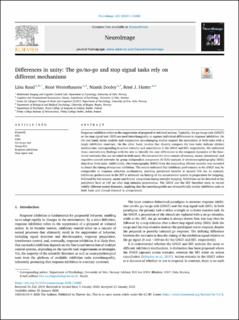| dc.contributor.author | Raud, Liisa | |
| dc.contributor.author | Dooley, Niamh | |
| dc.contributor.author | Westerhausen, René | |
| dc.contributor.author | Huster, René J. | |
| dc.date.accessioned | 2021-05-18T07:44:29Z | |
| dc.date.available | 2021-05-18T07:44:29Z | |
| dc.date.created | 2020-10-06T12:06:51Z | |
| dc.date.issued | 2020 | |
| dc.Published | NeuroImage. 2020, 210 1-14. | |
| dc.identifier.issn | 1053-8119 | |
| dc.identifier.uri | https://hdl.handle.net/11250/2755349 | |
| dc.description.abstract | Response inhibition refers to the suppression of prepared or initiated actions. Typically, the go/no-go task (GNGT) or the stop signal task (SST) are used interchangeably to capture individual differences in response inhibition. On the one hand, factor analytic and conjunction neuroimaging studies support the association of both tasks with a single inhibition construct. On the other hand, studies that directly compare the two tasks indicate distinct mechanisms, corresponding to action restraint and cancellation in the GNGT and SST, respectively. We addressed these contradictory findings with the aim to identify the core differences in the temporal dynamics of the functional networks that are recruited in both tasks. We extracted the time-courses of sensory, motor, attentional, and cognitive control networks by group independent component (G-ICA) analysis of electroencephalography (EEG) data from both tasks. Additionally, electromyography (EMG) from the responding effector muscles was recorded to detect the timing of response inhibition. The results indicated that inhibitory performance in the GNGT may be comparable to response selection mechanisms, reaching peripheral muscles at around 316 ms. In contrast, inhibitory performance in the SST is achieved via biasing of the sensorimotor system in preparation for stopping, followed by fast sensory, motor and frontal integration during outright stopping. Inhibition can be detected at the peripheral level at 140 ms after stop stimulus presentation. The GNGT and the SST therefore seem to recruit widely different neural dynamics, implying that the interchangeable use of superficially similar inhibition tasks in both basic and clinical research is unwarranted. | en_US |
| dc.language.iso | eng | en_US |
| dc.publisher | Elsevier | en_US |
| dc.rights | Navngivelse 4.0 Internasjonal | * |
| dc.rights.uri | http://creativecommons.org/licenses/by/4.0/deed.no | * |
| dc.title | Differences in unity: The go/no-go and stop signal tasks rely on different mechanisms | en_US |
| dc.type | Journal article | en_US |
| dc.type | Peer reviewed | en_US |
| dc.description.version | publishedVersion | en_US |
| dc.rights.holder | Copyright 2020 The Authors. | en_US |
| dc.source.articlenumber | 116582 | en_US |
| cristin.ispublished | true | |
| cristin.fulltext | original | |
| cristin.qualitycode | 2 | |
| dc.identifier.doi | 10.1016/j.neuroimage.2020.116582 | |
| dc.identifier.cristin | 1837524 | |
| dc.source.journal | NeuroImage | en_US |
| dc.source.40 | 210 | |
| dc.identifier.citation | NeuroImage. 2020, 210, 116582. | en_US |
| dc.source.volume | 210 | en_US |

